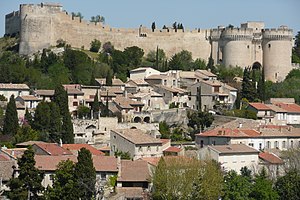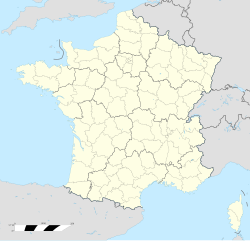| Fort Saint-André | |
|---|---|
| Villeneuve-lès-Avignon, Gard, France | |
 View to the Fort Saint-André over the town of Villeneuve | |
| Type | Castle |
| Site information | |
| Owner | Centre des monuments nationaux |
| Open to the public | Yes |
| Condition | Ruined; ramparts survive |
| Site history | |
| Built | 1292 |
| Built by | Philip IV of France |
The Fort Saint-André is a medieval castle in the commune of Villeneuve-lès-Avignon in the Gard département of France, dating to the late 13th century.[1]
History[]
Ordered in 1292 by Philip IV of France (known as "Philip the Fair"), the castle's role was to show the power of the Kingdom of France at its border with the Papal State across the river in the town of Avignon. From the castle ramparts, the papal fortress is clearly visible. The castle was built on Mount Andaon for protection, with a curtain wall that enclosed the Benedictine abbey which had occupied the site since the 10th century.
Mount Andaon is a rocky outcrop with steep sides to the north and the east that rises to 50 m above the floodplain of the Rhone. Prior to the 1770s the Rhone flowed next to the base of the eastern side of the mount. The plateau at the top extends for around 220 m in an east-west direction and 160 m north-south. It is not flat but rises from south to north by 24 m. The perimeter wall of the fort encloses an area of around 3.5 hectare.[2]
The castle owes the form in which it survives today to its last architect, Jean de Loubières (known as Jean du Louvre) who was also the architect of the Papal palace, just across the river Rhone. The construction was finished in the reign of Charles V (r. 1338-1380).
Preservation[]
The Fort Saint-André is included as a monument historique by decrees of the 25 April 1903 and 14 November 1925.[1] The site is regularly open to the public for a fee, though it receives a fraction of the visitors at the nearby Palais des Papes.
Gallery[]
See also[]
| Wikimedia Commons has media related to Fort Saint-André. |
- List of castles in France
- Tower of Philip the Fair - a contemporary construction only a few hundred meters from the castle
Notes[]
- ↑ 1.0 1.1 Ministry of Culture: Fort Saint-André (ancien château) (French)
- ↑ Barruol, Sournia & Vayssettes 2001, pp. 49-50.
References[]
- Barruol, Guy; Sournia, Bernard; Vayssettes, Jean-Louis (2001). "L'Abbaye Saint-André-lès-Avignon: histoire, archéologie, rayonnement". In Barruol, Guy; Bacou, Roseline; Girard, Alain (in French). Alpes de Lumière. pp. 49–68. ISBN 2-906162-54-X..
Further reading[]
- Bonnel, Émile (1963). "Congrès archéologique de France, 121e session, 1963, Avignon et Comtat Venaissin" (in French). Société française d'archéologie. pp. 202–205..
- Labande, M. L.-H. (1910). "Congrès archéologique de France, 76e session, 1909, Avignon. Volume 1 Guide du Congrès" (in French). Picard. pp. 131–138. http://gallica.bnf.fr/ark:/12148/bpt6k35679q/f254.image.. Includes a plan of the gatehouse and a cross-section.
- Maigret, Chantal (2000). "Congrès archéologique de France, 157e session, 1999, Gard". Société française d'archéologie. pp. 489–493..
- Payan, Paul (2001). "L'Abbaye Saint-André-lès-Avignon: histoire, archéologie, rayonnement". In Barruol, Guy; Bacou, Roseline; Girard, Alain (in French). Alpes de Lumière. pp. 155–160. ISBN 2-906162-54-X..
- Sagnier, A. (1882). "Bulletin Historique et archéologique de Vaucluse" (in French). Seguin Frères. pp. 492–504. http://gallica.bnf.fr/ark:/12148/bpt6k5787405h/f503.image..
External links[]
- "Official website". http://fort-saint-andre.monuments-nationaux.fr/. Retrieved 11 February 2013.
- Ministry of Culture listing for Fort Saint-André (French)
- Ministry of Culture photos
The original article can be found at Fort Saint-André (Villeneuve-lès-Avignon) and the edit history here.





